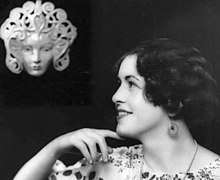Marguerite Mahood
Dr. Marguerite Mahood (born 1901 in Melbourne, Victoria, Australia, died 1989),[1] also known as Ma Mahood, was a painter, potter, printmaker and art historian.
Dr. Marguerite H. Mahood | |
|---|---|
 | |
| Born | 1901 Melbourne, Australia |
| Died | 1989 (aged 87–88) Toorak, Australia |
| Nationality | Australian |
| Education |
|
| Style |
|
| Spouse(s) | Thomas Orrock George Mahood ( m. after 1923) |
Biography
Marguerite Henriette Mahood (1901–1989), artist, was born on 29 July 1901 at Richmond, Melbourne, eldest child of Victorian-born parents Henry George Callaway, accountant, and his wife Marguerite Gabrielle, née Deschamps.[2] Marguerite was educated at Mrs Strickland’s school, Armadale, and Presbyterian Ladies’ College, East Melbourne, before attending drawing classes at the National Gallery school of drawing with Frederick McCubbin.[2] Academic training developed her natural talent and she became a capable and inventive draughtswoman. On 16 June 1923 at the Independent Church, Collins Street, she married with Congregational forms Thomas Orrock George Mahood,[2] an engineer.
During the 1920s Mahood established herself as a professional artist, producing drawings, watercolours, linocuts and oil paintings. Her early work showed enduring influences—the romantic aesthetic of the Pre-Raphaelite and Art Nouveau movements and a fascination with history and fantasy. She also produced numerous illustrations, cartoons and humorous stories for books, magazines and advertisements.
After establishing herself as a graphic artist and watercolourist in the 1920s, Mahood joined the Victorian Artists Society and exhibited regularly. During the Second World War she also exhibited with the Melbourne Social Realism group, which included Noel Counihan, Josl Bergner, Victor O'Connor, Peter Benjamin Graham, Herbert McClintock, Frank Andrew, and Nutta Buzzacott.
In 1926 she became one of the first women in Australia to broadcast her own radio program,[2] presenting a popular weekly discussion of art and decoration on 3LO until 1929. In the early days of radio, she lectured on design and wrote articles for the Listerner-in and its Sydney counterpart Radio.
Inspired by Asian and Islamic ceramics, European commercial potteries such as Sèvres, Meissen and Wedgwood, and English art pottery of the late 19th century, Mahood was also drawn to Neo-Gothic motifs: playful dragons appeared repeatedly in her work. Beginning with a wheel and kiln built by her husband, she undertook all aspects of production, from sieving and wedging the clay to the arduous task of stoking the kiln in her backyard studio. She advocated a high degree of technical control and was noted for the wide range of her glazes. A Herald reviewer described her in 1935 as 'unique among Victorian pottery workers in her colour range . . . a mistress of the dark rites of firing and glazing'. Meticulously numbered and often bearing her distinctive monogram, her work was easily identifiable. Detailed 'kiln books' ensured she avoided repeating mistakes and was able to continually refine her technique.
From 1932 until the 1950s Mahood’s regular exhibitions—held at the Sedon Galleries (1934–50), as well as with the Victorian Artists Society, the Melbourne Society of Women Painters, and the Arts and Crafts Society[2]—received glowing reviews. She was included in William Moore’s The Story of Australian Art (1934), the first national survey of the field. A founding member of the Australian Ceramic Society and the Victorian Sculptors’ Society, she also wrote articles in Australian Home Beautiful that advised amateur potters—women in particular—on the ceramic process. Other articles dealt with the history of pottery and the Australian ceramics industry, which she vigorously promoted
Mahood’s ceramic work eased after the birth of her son in 1938. The increasing popularity of stoneware, changing taste in art and interior decoration, and her age influenced Mahood’s decision to cease her ceramic practice. Her last ceramics were produced for the Melbourne Olympic Games Arts Festival in 1956. She continued to produce graphic works throughout her life, and during the 1940s and 1950s (as Margot Mahood) became a popular children’s cartoonist, writing and illustrating The Whispering Stone: An Australian Nature Fantasy (1944), and Drawing Australian Animals (1952).
Later, Mahood turned to academic life, earning a Master of Arts and Doctor of Philosophy degrees in history, with a doctoral thesis on Australian political cartoons in the late 19th century at the University of Melbourne[3] (BA, 1961; MA, 1965; Ph.D., 1970). Her doctoral thesis was published as The Loaded Line: Australian Political Caricature 1788–1901 (1973), a seminal study of Australian cartoons. Described in 1970 as a 'youthful, comfortably built woman' with grey, curly hair and hazel eyes, she continued to work in this field well into her eighties. Widowed in 1977, Marguerite Mahood died on 14 October 1989 at Toorak, survived by her son; she was cremated. While the Sydney Technological (Powerhouse) Museum was the only institution to acquire her ceramics during her lifetime, her work is now held in national, State and regional collections.
References
- "Marguerite Mahood". National Gallery of Victoria. Retrieved 14 October 2017.
- Bunbury, Alisa. "Mahood, Marguerite Henriette (1901–1989)". Australian Dictionary of Biography. Australian National University. Retrieved 14 October 2017.
- Timms, Peter and Kerr, Joan. "Marguerite Henriette Mahood b. 29 July 1901". Design & Art Australia Online. Retrieved 14 October 2017.
- Mahood, Marguerite, The Loaded Line: Australian Political Caricature 1788 - 1901, Melbourne University Press, Melbourne, 1973.
- The Printmakers, Important Woman Artists Gallery, Catalogue Melbourne, 1977.
- Germaine Max, Artists and Galleries of Australia, Boolarong Publications, 1984.
- Alisa Bunbury, Mahood, Marguerite Henriette (1901–1989), Australian Dictionary of Biography, Volume 18, Melbourne University Press, Melbourne, 2012.